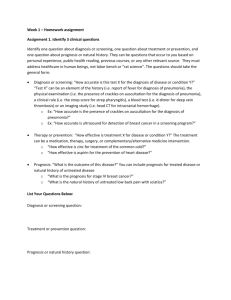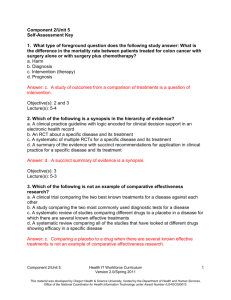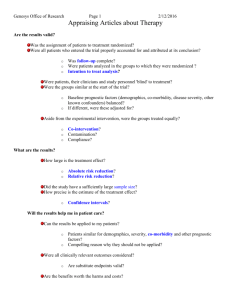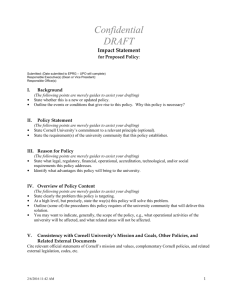EBM Master Worksheet - Weill Cornell Medical Library
advertisement
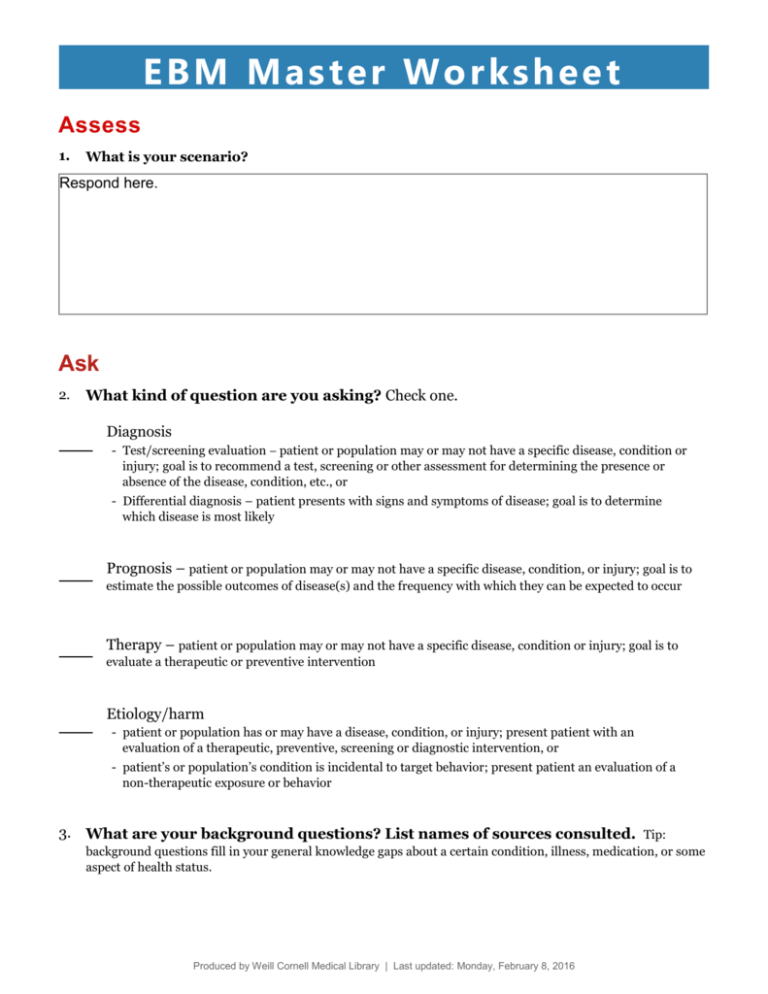
EBM Master Worksheet Assess 1. What is your scenario? Respond here. Ask 2. What kind of question are you asking? Check one. Diagnosis - Test/screening evaluation – patient or population may or may not have a specific disease, condition or injury; goal is to recommend a test, screening or other assessment for determining the presence or absence of the disease, condition, etc., or - Differential diagnosis – patient presents with signs and symptoms of disease; goal is to determine which disease is most likely Prognosis – patient or population may or may not have a specific disease, condition, or injury; goal is to estimate the possible outcomes of disease(s) and the frequency with which they can be expected to occur Therapy – patient or population may or may not have a specific disease, condition or injury; goal is to evaluate a therapeutic or preventive intervention Etiology/harm - patient or population has or may have a disease, condition, or injury; present patient with an evaluation of a therapeutic, preventive, screening or diagnostic intervention, or - patient’s or population’s condition is incidental to target behavior; present patient an evaluation of a non-therapeutic exposure or behavior 3. What are your background questions? List names of sources consulted. Tip: background questions fill in your general knowledge gaps about a certain condition, illness, medication, or some aspect of health status. Produced by Weill Cornell Medical Library | Last updated: Monday, February 8, 2016 Respond here. 4. What is your PICO? Patient/Population – most important characteristics and/or conditions. Respond here. Intervention/Exposure • Diagnosis – clinical assessment, screening, or diagnostic test • Prognosis – either: A) assessment of an outcome over time, or B) assessment of one or more predictors, or C) evaluation of the clinical use of prognostic information • Therapy – medical, surgical or preventive intervention • Etiology/harm – either: A) therapeutic, diagnostic, prognostic or preventive intervention, or B) nontherapeutic exposure or behavior Respond here. Comparison • Diagnosis: compared to an alternative or standard assessment; sometimes answer is “nothing” • Prognosis: compared to an alternative or standard care; sometimes answer is “N/A” • Therapy: compared to an alternative or standard treatment when evaluating the use of prognostic information; sometimes answer is “N/A” or “placebo” • Etiology/harm: compared to a control or alternative exposure; sometimes answer is “N/A” Produced by Weill Cornell Medical Library | Last updated: Monday, February 8, 2016 Respond here. Outcome • Diagnosis – measures of likelihood of disease; measure of performance; or measure of utility/practicality of screening, test, or other assessment; often enough, the goal of a diagnostic question is to find a “sensitive and specific” measure • Prognosis – likelihood of outcome, effect of predictor(s) on likelihood of outcome, or magnitude of effect of use of prognostic information • Therapy – measures of likelihood on patient important outcomes • Etiology/harm – measures of effect on likelihood of an outcome attributable to the intervention, or effect attributable to the exposure or behavior Respond here. 5. Clearly and concisely state your foreground question. Tips: use the components of your PICO. Try to avoid ambiguous terms such as “best.” Respond here. Acquire 6. What study type is best suited for answering this type of question? Check all that apply. case control study meta-analysis cohort study guideline randomized controlled trial health technology assessment systematic review other (specify) Produced by Weill Cornell Medical Library | Last updated: Monday, February 8, 2016 7. 8. What resource(s) did you choose to search in? PubMed EMBASE PubMed Clinical Queries PIER Cochrane Library Clinical Evidence Trip Database other (specify) Delineate your search strategy in writing (or attach your strategy). Be sure to include important keywords and MeSH terms, that is, list significant words, phrases, and subject headings. List Boolean operators used. Tip: if using PubMed, copy the relevant search(es) from the “History” tab. Respond here. 9. List those article(s) that you will appraise. Tip: if available, include a PMID. Respond here. Appraise 10. To what extent are the results valid? Points of discussion should include: a description of the study population, study methodology, treatments and outcomes measured, assessment of follow-up (i.e. sufficiently long and complete?). • Diagnosis: Produced by Weill Cornell Medical Library | Last updated: Monday, February 8, 2016 - For test/screening evaluation – Did participating patients present a diagnostic dilemma? Did investigators compare the test to an appropriate, independent reference standard? Were those interpreting the test and reference standard blind to the other results? Did investigators perform the same reference standard to all patients regardless of the results of the test under investigation? - For differential diagnosis – What were the diagnoses and their probabilities? How precise were estimates of disease probability? • Prognosis: Was the sample of patients representative? Were the patients sufficiently homogeneous with respect to prognostic risk? Was follow-up sufficiently complete? Were outcome criteria objective and unbiased? • Therapy: Are the groups balanced at the beginning? Throughout the study? At the end? Were patients randomized and was the allocation concealed? • Etiology/harm: Were patients similar for prognostic factors known to associated with the outcome, or did statistical adjust level the playing field? Were the circumstances and method for detecting the outcome similar? Was the follow-up sufficiently complete? • Summaries of evidence (meta-analyses, systematic reviews, etc.): Did the review explicitly address a sensible clinical question? Was the search for relevant studies detailed and exhaustive? Were the primary studies of high methodologic quality? Were selection and assessments of studies reproducible? Respond here. 11. What are the study’s results? Point of discussion should include a comprehensive description of the study findings, including key statistical findings. • Diagnosis, single study: - For test/screening evaluation – What likelihood ratios were associated with the range of possible test results? - For differential diagnosis – What were the diagnoses and their probabilities? How precise were estimates of disease probability? • Prognosis, single study: How likely are the outcomes over time? How precise are the estimates of likelihood? • Therapy, single study: What is the size of the effect? What is the precision of the effect? • Etiology/harm, single study: How strong is the association between exposure and outcome? How precise was the estimate of risk? • Summaries of evidence (meta-analyses, systematic reviews, etc.): Were the results similar from study to study? What are the overall results of the review? How precise were the results? Produced by Weill Cornell Medical Library | Last updated: Monday, February 8, 2016 Respond here. 12. To what extent can I apply the results to my “patient”? Points of discussion should include an assessment of whether your “patient” is different or similar than those in the study. • Diagnosis, single study: - For test/screening evaluation – Will the reproducibility of the test result and its interpretation be satisfactory in my clinical setting? Are the study results applicable to the patients in my practice? Will the test results to the patients in my practice? Will the test results change my management strategy? Will patients be better off as a result of the test? - For differential diagnosis – Are the study patients and clinical setting similar to mine? Is it unlikely that disease possibilities or probabilities have changed? • Prognosis, single study: Were the study patients and their management similar to those in your practice? Was the follow-up sufficiently long? Can you use the results in the management of patients in your practice? • Therapy, single study: To what extent do the outcomes of the study match those of my patient? Are the benefits worth the harms and costs? • Etiology/harm, single study: Were the study patients similar to the patient(s) in my practice? Was follow-up sufficiently long? Is the exposure similar to what might risk occur in my patient? What is the magnitude of the risk? Are there any benefits that are known to be associated with exposure? • Summaries of evidence (meta-analyses, systematic reviews, etc.): Were all patient-important outcomes considered? Are any postulated subgroup effects credible? What is the overall quality of the evidence? Are the benefits worth the costs and potential risks? Produced by Weill Cornell Medical Library | Last updated: Monday, February 8, 2016 Respond here. Apply 13. Present your recommendations as if you are talking to your “patient.” Use simple, non-technical words. Explain the nature of the “patient’s” complaint, what options are available, and, based on the evidence, the strengths and weaknesses of each option to help the “patient” make an informed decision. Respond here. Produced by Weill Cornell Medical Library | Last updated: Monday, February 8, 2016

